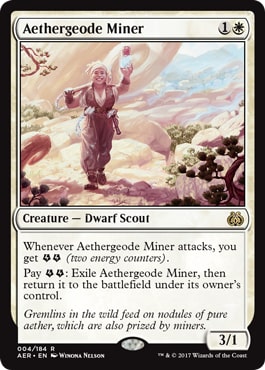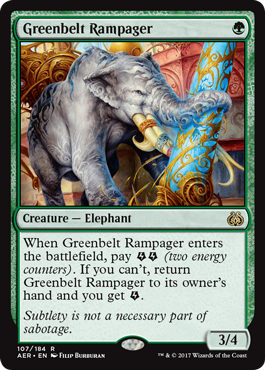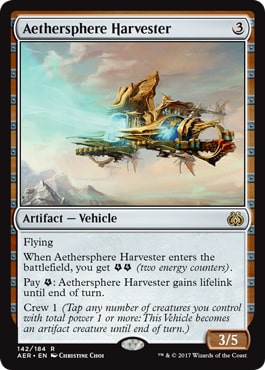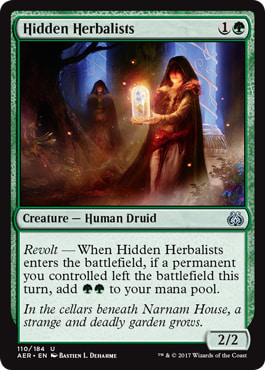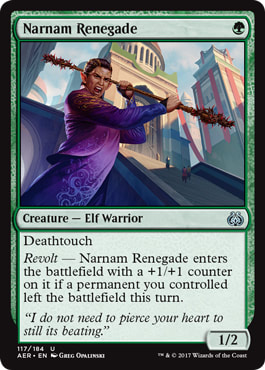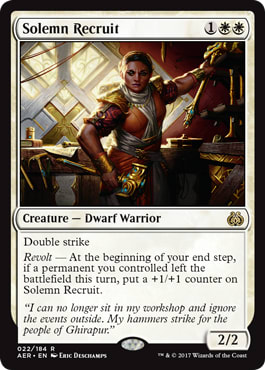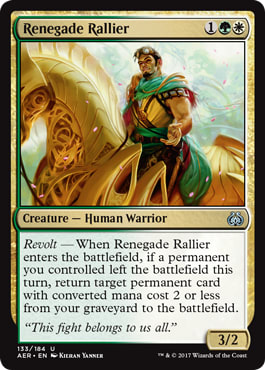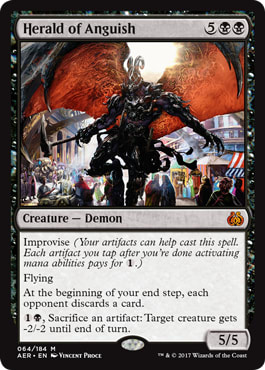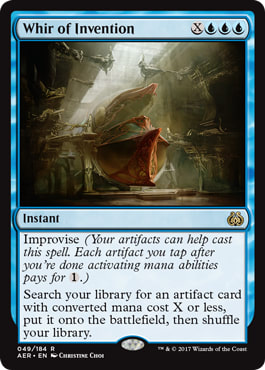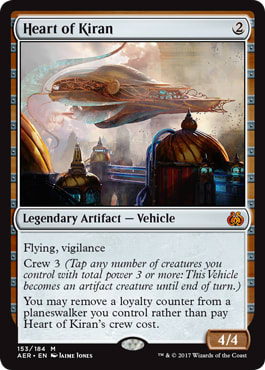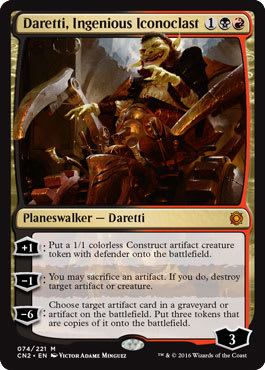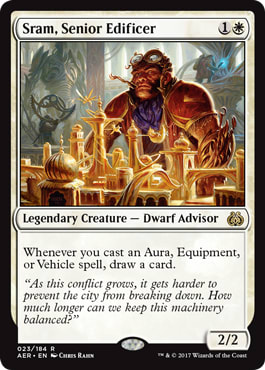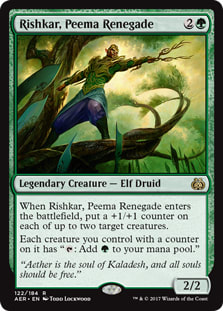Aether Revolt has been dubbed as one of the most pushed sets since New Phyrexia. It features many cards with hallmarks for doing broken things — casting things for free, pushed cheap cards, and several upgrades as riffs on other cards. In this review, I'll talk about how Aether Revolt impacts Cube.
Of note: Although this set review has been released after the prerelease, please note that these are based on actual play in my Cube and not merely outsourced to playing at the prerelease. If I'm saying a card has been working well based on my experience, it's based on actual experience from trying them out in my Cube and finding the cards actually have been working well in my Cube.
My 465-powered Cube list is the list used for context and despite inaccurate false dichotomies about how power can warp a Cube, your Cube experience with these cards likely will mirror mine.
This first part will cover the cards via set mechanic and the 5-card legendary creature cycle, with the second part covering the rest of the cards from Aether Revolt, starting with the expertise cycle.
Energy
Like Kaladesh, Aether Revolt gives us several cards with Energy. Since the mechanic has only been used in one other set, we'll be evaluating the quality of these cards as if they were your only Energy card.
Aethergeode Miner, Glint-Sleeve Siphoner, Aether Chaser
These 3 energy cards trigger on attacking and, as such, their role is best served in “attacking” decks.
Aethergeode Miner is a card that hits the primary marks for a White Cube aggro card: nice base stats as a 3/1 for ![]()
![]() with a relevant ability for protecting itself. However, I found that I was less impressed with this than I'd initially thought I would. Since it requires surviving an attack cycle to be able to blink itself, its bonus text didn't pay off as well as I'd have liked. It occupies a space similar to Accorder Paladin — a White attacking 2-drop which isn't as important as its 1-drops and only somewhat aligns with what the deck wants. Because of that, it's likely going to be a rough sell.
with a relevant ability for protecting itself. However, I found that I was less impressed with this than I'd initially thought I would. Since it requires surviving an attack cycle to be able to blink itself, its bonus text didn't pay off as well as I'd have liked. It occupies a space similar to Accorder Paladin — a White attacking 2-drop which isn't as important as its 1-drops and only somewhat aligns with what the deck wants. Because of that, it's likely going to be a rough sell.
Glint-Sleeve Siphoner’s most obvious analogue is something like Dark Confidant as a 2/1 for 2 in Black that draws and makes you lose life, but the better comparison is to something like Elvish Visionary. This is because it requires an attack to have enough Energy to draw the first card, and then it requires multiple turns (2 more attacks) to reload. While it may look easy to grind out that value, it's harder than you'd think, even with Menace, as it's vulnerable to die in other ways than being blocked, which makes it worse than it looks. My general impression from trying it out was that it was pretty mediocre, unfortunately.
Aether Chaser, much like Thriving Grubs, is a member of a common energy cycle and coincidentally has the best chance of making it into Cubes on its base stats.
Aether Chaser is a mid-tier Red 2-drop that would have been welcome years ago, but finds itself having a harder time making it into Cubes now, much like Thriving Grubs. I've heard comparisons to Mogg War Marshal, a card that I've grown to like through its roles as a nice defensive creature that offers several bodies while still being playable in aggressive decks, its role is more to gum up the ground and hope to soak up some damage for the later stages of the game.
Since Aether Chaser has to attack to trigger its ability, it doesn't really occupy the same deck space as Mogg War Marshal since it needs to get in the red zone before it can generate a Servo which can then attack next turn. Because of this, it isn't quite the 2/1 first strike + 1/1 body that it first appears to be and doesn't offer Red aggressive decks the return on investment for damage that they typically are in the market for. Since it has to attack to get its payoff, it's relegated mainly to aggressive decks, putting it in a rough position. It has some synergies with cards that care about multiple bodies — equipment, sacrifice engines, etc, but as Red 2-drops aren't nearly as important as the bread-and-butter 1-drops, that really isn't enough to have it make the final 40 of most Red aggro decks.
Others
Greenbelt Rampager requires ![]()
![]()
![]() to be of any use, and as
to be of any use, and as ![]()
![]()
![]() for a 3/4 isn't that great of a deal in Cube, it's weak for the environment. While it can be paid in installments, it's still a bit too pricey and mana intensive for Cube.
for a 3/4 isn't that great of a deal in Cube, it's weak for the environment. While it can be paid in installments, it's still a bit too pricey and mana intensive for Cube.
Aethersphere Harvester is no Smuggler's Copter, but it has some legs as a 2nd-tier equipment by boosting small creatures. Evaluating it as a stand-alone card means that it can get lifelink twice, but even the threat of activation can prevent an opponent from attacking if it represents the attack being fruitless. Being a 3/5 ends up stopping most creatures that aren't Titan-sized and it's pretty difficult to kill in combat, making it a solid role-player as an artifact that plays in decks that are in the market for something other than a mana rock.
Revolt
It's harder to get Revolt going in Cube than in a format like Modern, where cards pushed for that format did so with the specific context that fetchlands make Revolt easier to hit.
With creatures, it's more fundamentally important for them to be cast on-curve; whereas with non-creatures, they can be cast off-curve — although we'd ideally want them to be cast on curve as well — as it isn't as important to cast, say, a Fatal Push on turn one vs turn four, as the deprecation in value from a Fatal Push on turn four isn't as bad as something like a Narnam Renegade on turn four.
That said, you can take some steps as a Cube designer to help these cards reach their potential.
I talked with Matt Kranstuber about how often it triggers, and we figured that it was about as often as something like Morbid. He talked about how he's adding several cards like the Mirage fetchlands (Bad River, Rocky Tar Pit, etc) that can help more reliably hit Revolt without negatively impacting your own board state. These cards can, in theory, act like Rogue Elephant where you sacrifice some board presence for a large creature, but you really don't want to be doing that.
Existing cards like Strip Mine, Wasteland, Keldon Marauders, Sakura-Tribe Elder and Yavimaya Elder can help with enabling Revolt. However, there isn't really the critical mass to make a “revolt deck” but having cross-synergies is useful for those cards.
In addition to the 5 Mirage fetches and other “slow fetches” like Terramorphic Expanse and Evolving Wilds, both solid Cube cards in their own right, some other examples of cards that can provide sacrifice fodder without making your board suffer too much; cards that aren't included in the Cube Tutor 450-card average:
- Mortarpod
- Tectonic Edge
- Eldrazi Displacer
- Crystal Shard
- Kor Skyfisher
- Parallax Wave
- Waterfront Bouncer
- Bone Shredder
- Mardu Strike Leader
- Sidisi, Undead Vizier
- Smallpox
- Seal of Fire
- Evolutionary Leap
As you've noticed, however, it's hard to cast these in the same turn as a low-cost card with Revolt, although some cards do set up for some free use on the turn after, like Parallax Wave.
Because of this, it's going to be incredibly hard to curve out with these Green creatures.
The Revolt creatures with aggressive body mostly exist in green. It’s hard to “curve out” with these, and because of that, the following 3 creatures may be difficult to place into your Cube without significant effort to make them work:
However, once we start going up the mana curve, it's easier to get Revolt going on these slightly higher-cost ones to get revolt on curve, so we can evaluate them with that context.
Solemn Recruit's obvious analog is Mirran Crusader, dropping Golgari protection for the ability to grow. It's easier to “curve out” since it can do it each turn and I found that it works incredibly well in decks that have cannon fodder to throw at an opponent, whether it's through sacrifice engines or even just tokens to chump attack. While White 3-dropss have been getting slowly better over the years, this occupies a nice space as a solid tool for aggressive decks.
Renegade Rallier is actually quite strong, but it suffers from being in an incredibly competitive multicolored guild. It makes chump attacks much better and has very good base stats. It has some solid potential since it can re-grow a lot of things that trigger its revolt (fetchlands, Sakura-Tribe Elder, etc.)
Fatal Push gives Black another conditional 1-mana removal while it typically has to rely on 2-mana removal spells like Go For the Throat. Let's do a side-by-side comparison with Disfigure, a pretty similar analog as a 1-mana Black removal spell that deals with small creatures. For these, I won't consider armies in a can like Cloudgoat Ranger and Avenger of Zendikar because while sometimes you've gotta push a token out of the way, most of the time, that's not what these cards are doing.
By the numbers:
What BOTH Disfigure and Fatal Push kill without revolt.: 64 (examples: Grim Lavamancer, Lotus Cobra)
What BOTH Disfigure and Fatal Push kill with revolt: 33 (examples: Oracle of Mul Daya, Goblin Rabblemaster)
What Disfigure kills and what Fatal Push can't, even with revolt: 3 (Shriekmaw, Kiki-Jiki, Mirror Breaker, Mulldrifter, Acidic Slime) — all of these being Mulldrifters whose main value comes outside of the creature itself.
What Disfigure can't kill but Fatal Push can, without revolt: 12 (Thing in the Ice, Celestial Colonnade)
What Disfigure can't kill but what Fatal Push can with revolt: 21 (Courser of Kruphix, Hellrider, Kalitas, Traitor of Ghet)
For reference, 30 creatures can't be killed by either Disfigure or Fatal Push , creatures like Consecrated Sphinx, Sarkhan, the Dragonspeaker, and Baneslayer Angel. Unsurprisingly, these are the highly efficient Baneslayers of the format.
If we go by raw numbers and assume that Fatal Push can't reliably hit Revolt, Disfigure comes out slightly ahead, but that doesn't tell the entire tale. Approaching these creatures as Baneslayers and Mulldrifters allows us to see that Fatal Push is able to kill Baneslayers like Kalitas and creature lands like Celestial Colonnade. Generally, the quality of the removal represented is slightly higher with Fatal Push than Disfigure. One can argue that you can chump attack with a lot of creatures to enable revolt, but much like trying to do that with Tragic Slip, it can't really get large blockers out of the way reliably.
Fatal Push loses out on combat trick potential, but general experience with Disfigure when I had it in my Cube and playing it in others', generally that mode wasn't used very much, despite how powerful and impacting it may look in combat. Some decks don't really use Baneslayers and when a control opponent just has Solemn Simulacrum, Mulldrifter and Shriekmaw-style creatures as their creature suite, Fatal Push isn't very good (but then again, would a card like Go For the Throat been much better? Besides, that's what your sideboard is for!)
As for the other non-creature spells with Revolt, they don't compete very well in Cube, unfortunately, as they either require too much setup to be worthwhile (Call for Unity) or don't do enough for their cost (Aid from the Cowl.) Hidden Stockpile has the best potential as a great sacrifice engine that can act as a pseudo Sensei's Divining Top and a great value engine, but it has a hard time competing with Orzhov's great Planeswalkers and removal effects.
Improvise
Cost-reduction mechanics tend to have the potential for broken-ness, and usually lead to a Cubeworthy card or two. Convoke is the most obvious analog, which brought Cube designers Stoke the Flames and (to a lesser extent) Chord of Calling. Development described it as a one-shot affinity, since they figured that bringing back Affinity for Artifacts could have had a disastrous outcome. It was usually safe to assume that convoke generally reduced the cost of a spell by 1 since creatures are pretty abundant and it wasn't hard for cards like Stoke the Flames to be cast for free, but because artifacts aren’t able to pay for the colored-mana requirements it is impossible for colored Improvise spells to be free, which was typically possible with Convoke. It's similar to how you may have some artifacts to tap for Tangle Wire, but a lot of them tend to just be mana generators anyway. Looking at the CubeTutor 450-average:
24 Artifacts and Equipment: Bonesplitter, Pithing Needle, Sensei's Divining Top, Skullclamp, Isochron Scepter, Lightning Greaves, Umezawa's Jitte, Winter Orb (new text allows it to be turned off), Crucible of Worlds, Mimic Vat, Grafted Wargear, 5 Swords, Tangle Wire, Vedalken Shackles, Nevinyrral's Disk, Smokestack, Batterskull, Birthing Pod, Whip of Erebos, Spear of Heliod
11 Creatures: Phyrexian Revoker, Spellskite, Lodestone Golem, Solemn Simulacrum, Wurmcoil Engine, Myr Battlesphere, Sundering Titan, Hangarback Walker, Porcelain Legionnaire, Sphinx of the Steel Wind, Baleful Strix
Unfortunately, most Improvise cards aren't that great for Cube. However, there are some standouts:
Herald of Anguish is the best creature with Improvise for Cube. To be on-curve, we'll want at least a 1-mana discount to be competitive with other high-cost Cube creatures and 2+ is the sweet spot, but looking at the raw numbers makes that difficult to achieve.
Whir of Invention: The obvious analogue is Chord of Calling, but one where you'll always have to pay at least ![]()
![]()
![]() , since colored artifacts, like Torrential Gearhulk, can’t pay for the colored costs. It typically ended up costing too much mana to be worth it.
, since colored artifacts, like Torrential Gearhulk, can’t pay for the colored costs. It typically ended up costing too much mana to be worth it.
Vehicles
Heart of Kiran is a vehicle that's still quite underrated for Cube. Let's look at a 3-0 deck that utilized Heart of Kiran which shows a pretty typical case for its use:
Heart of Kiran Example ? Cube | Usman Jamil
- Creatures (9)
- 1 Drana, Liberator of Malakir
- 1 Flametongue Kavu
- 1 Gonti, Lord of Luxury
- 1 Goblin Dark-Dwellers
- 1 Kalitas, Traitor of Ghet
- 1 Liliana, Heretical Healer
- 1 Ophiomancer
- 1 Pia and Kiran Nalaar
- 1 Wurmcoil Engine
- Planeswalkers (3)
- 1 Daretti, Ingenious Iconoclast
- 1 Liliana, the Last Hope
- 1 Ob Nixilis Reignited
- Instants (5)
- 1 Burst Lightning
- 1 Diabolic Edict
- 1 Hero's Downfall
- 1 Kolaghan's Command
- 1 Searing Blaze
- Sorceries (3)
- 1 Chain Lightning
- 1 Thoughtseize
- 1 Yahenni's Expertise
- Artifacts (3)
- 1 Black Lotus
- 1 Heart of Kiran
- 1 Rakdos Signet
- Lands (17)
- 6 Mountain
- 7 Swamp
- 1 Arid Mesa
- 1 Blood Crypt
- 1 Maze of Ith
- 1 Westvale Abbey
The prevailing argument is that Heart of Kiran is only playable in a “super friends” deck and saying that the above deck is a “super friends” deck would be quite a stretch. (looking at how many creatures in this deck crew it.)
Planeswalker loyalty doesn't tend to get utilized as a resource in Cube — most of the time, it builds up loyalty merely to stay alive and for the ability to threaten going ultimate, but for most Planeswalkers that have ultimates, they don't tend to happen very often.
Think to the last time you played a Planeswalker like Elspeth, Knight-Errant in a deck. She likely didn't ultimate in the time that you played her, quite rare for her to ultimate in a match, let alone a 3-match Cube session. It's true that increasing her loyalty somewhat pressures the opponent to deal with her or lose, but with something like Elspeth, Knight-Errant, most of the time, that isn't really a huge concern nor focus of the game, as it's more so about keeping her alive.
Heart of Kiran helps to utilize that resource by defending Planeswalkers incredibly well, as well as having a very fast clock to close out the game quickly.
From personal experience playing against that deck, the deck played Heart of Kiran and Daretti, Ingenious Iconoclast after that, which made it incredibly hard to attack Daretti since none of my creatures could outmuscle a 4/4, and as I was getting bashed for 4, it didn't really matter that it was losing loyalty, since I was dying. While it no longer was threatening going ultimate, the more immediate threat presented by Heart of Kiran was much more relevant. I asked him how Heart of Kiran performed and in other matches, it played pretty similarly (and that in the deck, it wasn't incredibly hard to crew.)
That being said, even though it can be crewed with crew 3, its best use is with a Planeswalker, as it allows it to play offense and defense incredibly well.
Experience shows that it requires a Planeswalker or two in the deck or a significantly high amount of 3-power creatures to be able to deliver on its payout; I wouldn't play Heart of Kiran in a deck that doesn't have at least 2 Planeswalkers, but if you do, Heart of Kiran works exceptionally well with those decks and rewards those decks handsomely.
Untethered Express – is an underrated vehicle that represents a 5/5 attacker. It's very similar to Renegade Freighter, as a way to boost smaller creatures into large trampling threats. Like Renegade Freighter, it can't immediately boost a creature and it does suffer from being at the same mana cost as many traditional aggro finishers like Hellrider, while being unable to close out the game that turn, requiring a 1-turn setup. However, it does represent an incredible rate of power increase due to its small crew cost and once it attacks a few times, few creatures in Cube can stop it. Much like Aethersphere Harvester, it isn't a tier-1 vehicle, but it's solid as a way to boost attacking decks since artifact support for those decks tends to be thin.
Legend Cycle
This cycle of legendary creatures was seemingly created in 2015, like Leovold, Emissary of Trest, during the time that Tiny Leaders was gaining popularity before it popularity tanked shortly after. Cube Tutor 450-card average Because of that, their power level was pushed for that format. How do these fare for Cube?
Sram, Senior Edificer is the only straight-up miss for Cube as the average Cube deck won't really be able to take advantage of it. Looking at the numbers, it only has about:
11 equipment: Skullclamp, Bonesplitter, Lightning Greaves, Umezawa's Jitte, Grafted Wargear, 5 Swords, Batterskull
8 auras: Faith's Fetters, Control Magic, Treachery, Necromancy, Animate Dead, Splinter Twin, Rancor, Song of the Dryads
3 vehicles: (The actual site average has 0, but we'll chalk this up to the site average being slow to adopt, but for the sake of argument, let's err on the side of inclusion by saying Smuggler's Copter, Fleetwheel Cruiser, and Skysovereign, Consul Flagship.)
This then begs the question of how many of these combined would realistically be needed to take advantage of him in Cube as, although his baseline stats aren't necessarily embarassing, they aren't really good enough on their own to be used without his draw trigger consistently firing off in a deck.
Him being a 2/2 for 2 with no bonuses is a rough sell for Cube, so he'll need to have enough targets to make him trigger consistently shortly after playing him, as playing a 2/2 for 2 that has a low chance of triggering is weak for Cube. Unlike something like tutoring creatures like Stoneforge Mystic, it needs to hit those naturally, so it requires a lot more targets and there just isn't enough to make that happen.
This will be difficult to reach in Cube decks and even if it does, the payoff for drawing a card or two isn't really that great either, considering how much doing so dilutes the deck as it requires drafting a lot of “multitaskers” — cards like Skysovereign, Fleetwheel Cruiser, Batterskull, Mortarpod and other cards that play the role of multiple types (creature + boost/removal + boost) and although it looks like it's got legs in Modern for a build-around deck, there isn't really the critical mass of targets for it in Cube.
Baral, Chief of Compliance's cost reduction for instants and sorceries is most similar to Goblin Electromancer. Due to multicolored slots being tighter than Mono-color due to the limited amount of decks that can play them (a card like Putrid Leech would be a near-staple in Green or Black, but nowadays finds itself on the outside looking in due to a very competitive Golgari guild.) Somewhat similar to a “mana rock” for instants and sorceries.
Most Blue decks tend to play a lot of instants and sorceries, and unlike Sram, it's a lot easier to hit a critical mass of targets to be worth playing.
Cards like Augur of Bolas weren't as good as they looked because the required amount of cards was too high. Looting when countering a spell does help it to boost counters, and turning a ![]()
![]() Miscalculation into
Miscalculation into ![]() , counter something and loot while you're at it is absurd value.
, counter something and loot while you're at it is absurd value.
All that being said, when I tried it out in Cube, I did find it underwhelming which was a bit surprising because I'd think it'd be a natural fit for the average Cube deck, as it was mostly a Goblin Electromancer, with some upside by upgrading some counterspells. When I had it in a mostly-Blue control deck, I found that I was underwhelmed by him, which prompted me to look at the Blue decks that have 3-0ed my Cube drafts in the past few years. Most didn't have that many cards that would benefit from the cost reduction, with most being in the 5-7 range. (With a few outliers, decks having 8, 9 and 10 respectively.) It's arguable that knowing Baral is in a Cube or taking it early can help to build around it, but is Baral really worth the payoff for building around him?
If you want to consider Baral for your Cube, take a good look at the composition of your Cube's Blue control decks to see if they'd truly benefit from it, however, this likely won't be the case.
Yahenni, Undying Partisan is another in the line of aggressive 3-drops, which have been pretty underrepresented in Cube thus far. Yahenni is a sacrifice engine, but one that doesn't reward you for making multiple sacrifices (Bloodghast, Bloodsoaked Champion, tokens). Yahenni is unlike other traditional sacrifice outlets like Braids, Smokestack and Goblin Bombardment or even something like a Carrion Feeder/Nantuko Husk, which reduces the card’s impact for decks that seek to make lots of sacrifice fodder. This makes Yahenni more at home either as a supplement to cards that work well with Braids/Smokestack, etc and/or as a role-filler in Black aggressive decks as a threat that can sacrifice other creatures to get around mass removal or act as a creature to turn the corner after a wrath. Its counter trigger isn't irrelevant either. As we saw through cards like Kalitas, Traitor of Ghet, it isn't incredibly hard to have opposing creatures die, making Yahenni larger. That said, Yahenni is a bit too low impact for a lot of Cubes, even those that have decks with a lot of sacrifice fodder, and unfortunately doesn't tend to bolster most Black decks.
Kari Zev, Skyship Raider is somewhat similar to straight-up beaters like Borderland Marauder, but a more apt analog is Geist of Saint Traft. I initially made this comparison before designer Erik Lauer talked about how he compared Geist of Saint Traft to saboteur cards like Ophidian, which give a bonus if they're unblocked. Although, Geist was more subtle as it attacking meant it dealt a lot of damage, and it living to tell the tale meant that it could do so for later turns. Saboteurs without evasion have typically been weak and Geist got around that by having hexproof, demanding that the opponent have a blocker or some other way to deal with it or lose quickly.
Kari Zev is a riff on this as she doesn't have hexproof as protection, demanding that the opponent has to have an answer as soon as possible, else they're getting smacked by a Hell's Thunder every turn. Instead, her menace makes it so that she likely lives through whatever combat step she would encounter. While her having 1/3 body may look irrelevant, it's subtlety useful as it helps with double-blocks that could happen in the early stages of the game, where a random 1/1 would potential joins up with a larger blocker that would take her down.
Ragavan having no evasion means that it's easier to get brickwalled, and I've seen scenarios where it does stone nothing, either running into a 3/3 beast token or running into a wall (neither of which were enough to block Kari Zev). Even in those scenarios, Kari Zev was getting damage in. She combines with other sacrifice cards like Greater Gargadon and Goblin Bombardment which are fan favorites in Cube, and works well with other cards like Flesh Carver and Carrion Feeder, cards that work well in attacking Red strategies.
Costing ![]()
![]() helps her to fit into R/X decks and helps take some of the weight off of hard-to-cast
helps her to fit into R/X decks and helps take some of the weight off of hard-to-cast ![]()
![]() Red aggro beaters like Eidolon of the Great Revel. I'm honestly not quite as high on her as many others, but the competition isn't really there for 1st-tier Red attacking 2-drops. She's still a rock-solid Red attacker.
Red aggro beaters like Eidolon of the Great Revel. I'm honestly not quite as high on her as many others, but the competition isn't really there for 1st-tier Red attacking 2-drops. She's still a rock-solid Red attacker.
Rishkar, Peema Renegade was initially underrated for Cube when it came out, but since the first SCG open where an army of Green decks decks featuring Rishkar took over, people (but still not enough) are starting to come around to it. I was quite happy with it before then, which I discussed on Third Power episode discussing how it worked well based on real-world Cube experience.
Before we go into arguments I've heard against this card, let's look at a mostly-Green 3-0 deck that where someone had Rishkar and his expertise:
Rishkar, Peema Renegade Example ? Cube | Usman Jamil
- Creatures (17)
- 1 Arbor Elf
- 1 Craterhoof Behemoth
- 1 Deranged Hermit
- 1 Dragonlord Atarka
- 1 Elvish Mystic
- 1 Fauna Shaman
- 1 Fyndhorn Elves
- 1 Joraga Treespeaker
- 1 Llanowar Elves
- 1 Master of the Wild Hunt
- 1 Polukranos, World Eater
- 1 Primeval Titan
- 1 Rishkar, Peema Renegade
- 1 Rofellos, Llanowar Emissary
- 1 Sakura-Tribe Elder
- 1 Thragtusk
- 1 Woodfall Primus
- Sorceries (2)
- 1 Natural Order
- 1 Rishkar's Expertise
- Enchantments (2)
- 1 Curse of Predation
- 1 Sneak Attack
- Artifacts (4)
- 1 Boros Signet
- 1 Grim Monolith
- 1 Selesnya Signet
- 1 Sol Ring
- Lands (15)
- 3 Mountain
- 9 Forest
- 1 Kessig Wolf Run
- 1 Windswept Heath
- 1 Gaea's Cradle
Rishkar is incredibly flexible and works well with Green decks' game plans as it can go wide like a mini-anthem while being an efficient rate of return on raw power and toughness, similar to Verdurous Gearhulk. I've found that the much-feared worst case scenarios where it only had itself to pump didn't happen that often and that it was typically pumping at least itself and another thing, or two other creatures and attacking with them.
The mana ability may look useless as well. Why would someone want to use their 3-drop to ramp, since many of the best ramp cards cost 1-2 mana? I frequently saw plays like casting Rishkar, pumping up 2 non-summoning sick creatures, which both tapped to cast a 2-cost spell and threatened to cast a 6-drop next turn if not dealt with; forcing the opponent to either return serve or lose to the board position that seemingly came out of nowhere. When 1-mana elves were taken out of Standard so that they could push Green 3-drops, Rishkar is a perfect example of one. Don't sleep on Rishkar.
Stay tuned for part 2, which will cover the rest of Aether Revolt's Cube cards!
My blog, featuring my Pauper and powered Cube lists.
Cube podcast, The Third Power, that Anthony Avitollo and I host.
Find me on Twitter @UsmanTheRad
















